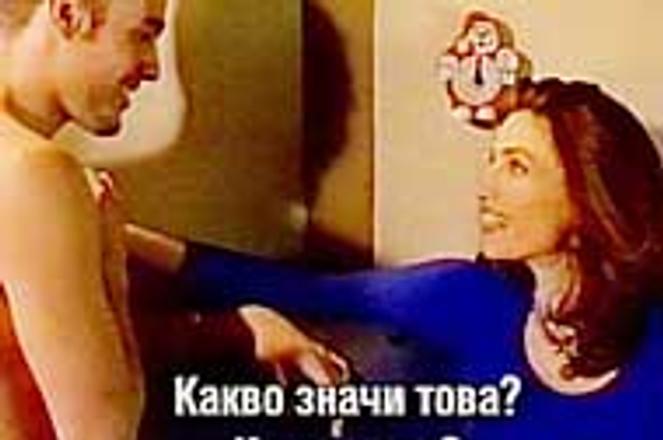DIGITAL prints from various movies are used to show misunderstandings in conversation.photo: Courtesy of Priestor
OUT OF sight for passersby, a house behind the diplomatic residences that line Bratislava's exclusive Palisády Street conceals a unique art gallery in its basement. Symbolically named Priestor (space), the gallery bills itself as a place where art remains a means of communication between people.
"It's for people who want to communicate through art as well as about art," says gallery founder Juraj Earný, 27.
The gallery's two dark rooms, buried beneath a labyrinth of corridors, contrast with the sun on the street above and the blossoms of the conservatively landscaped gardens. Inside, artwork exhibits and the tools of their creation have not yet been unpacked from their crates and boxes, even though a new exhibition is to open in two days.
Work on the exhibit finally started on June 6. Christened 'Upside Down', Earný explains, the show's name reflects the problems the gallery encounters every time a new event is planned, offering new approaches to contemporary art that are not yet widely popular.
"Until the very last moment I didn't know whether the exhibition would get to open or not. I'm still afraid that something will remain upside down," Earný says as he unpacks the displays.
The exhibit attempts to 'discuss' relations between men and women by experimenting with artistic techniques. The gallery is divided into a 'female room' and a 'male room', each exhibiting the different approaches to art favored by men and women. Some of the 11 exhibiting artists, whose work straddles the sexual divide, link the two separate spaces together.
THESE stills, from the film Practical Magic (Griffin Dunne, 1998) help the artist communicate with audiences.photo: Courtesy of Priestor
"I've noticed that female artists focus more on the subjects of their inspiration, whereas men focus on the means of creating art, forms of presentation and how they can manipulate world issues. I wanted to connect the two worlds together," says Earný.
Bulgarian Krassimir Terziev, as well as Yugoslav artistic couple Vladimir Nikolia and Vera Veeanski, provide the works that link those worlds. While Terziev displays digital prints he cut out of sequences from different movies and organised into his own take on "What is Bulgaria", the couple produced a video called "How To Become a Great Artist", depicting the problems young artists face when entering the world of art, problems they do not learn to deal with at school. In a short video, a "Great Artist" ironically explains to a little girl how to become like him.
Established in 1999 as the only non-commercial gallery of contemporary art in Slovakia, Priestor has struggled financially from the outset. Moreover, Earný says, art publications have not been willing to give space to artists trying to develop, introduce or exchange new ideas on contemporary art.
"When we opened in 1999, there was no artistic magazine where people could talk about art. There was no communication between Slovak artists. So my goal with the gallery was to make artists think and express views on art that differed from accepted norms. At that time it was the most important step to changing the current situation," says Earný.
During Priestor's three years of existence, more than 6,000 people have visited the gallery's 33 exhibitions and participated in 48 lectures, presentations, international seminars, theatre plays and concerts. The discussion, for Earný, has begun in earnest.
The exhibit Space For Recapitulation was the gallery's first big project, introducing 19 young Slovak artists to the world. They were asked to choose artworks from history and interpret them from their own, contemporary perspective.
TERZIEV tells us about his countyfolk.photo: Courtesy of Priestor
As the year 2000 approached, the gallery's End of the Beginning & The Beginning of the End project prepared 15 exhibitions connected with the end of the millennium. Some of them attracted significant public notice, such as the work of Slovak artist Peter Agát Huba, who not only displayed his video art but also mixed music for visitors as a DJ, living in the gallery during the entire month the exhibit lasted.
"I wanted to have live art, not just dead exhibits," says Earný.
Experimental Laboratory, the last project staged in 2001, introduced new techniques in the creation of contemporary art. International artists, for instance, displayed works created in virtual reality.
However, while the number of artists switching from traditional to experimental art techniques is increasing, and despite the space Priestor affords to their work and opinions, some artists still claim they face obstacles to communicating not only with their audiences but also among themselves. The barriers, they say, are erected by art institutions that mediate an artist's work to the point that he or she disappears from view.
"There's not enough cooperation between individual artists," says Nikolie. "No matter how much I create I have the feeling that I am being neglected on the global level, because everything goes through curators and institutions, and does not involve individual artists at all."
What:Upside Down - exhibition.
Who: Gabika Binderová, Marko Blažo, Aneta Mona Chisa, Marek Kvetán (SK), Veronika Bromová, Zbigniew Libera (PL), Hajnal Németh (H), Vladimir Nikolia, Vera Veeanski (YU), Krassimir Terziev (BG), Maria Pask (NL).
When: Wed-Sun 16:00-19:00 until June 30.
Where: Galéria Priestor, Somolického 1/B
Tel: 02/5441-8510.
Admission: free
For more information on the gallery visit www.publicis.sk/priestor
Author: Mirna Šolie


